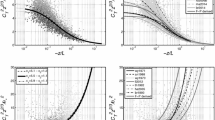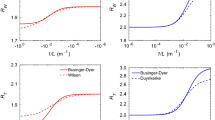Abstract
The validity of a common radiometeorological application of Monin-Obukhov (M-O) similarity theory to potential refractivity (χ), which is a nonlinear combination of θ and q, is determined by whether the properly nondimensionalized χ gradient is a universal function of z/L. We develop expressions for the flux of χ (and its scaling parameter, χ*) in terms of temperature and moisture fluxes, and an M-O similarity expression for the vertical χ gradient. Results show that even if θ and q are accepted as exactly following M-O similarity expressions, when the surface layer is stable, χ does not obey such an expression. That is, when properly nondimensionalized, the vertical gradient of χ does not collapse to a single universal function of z/L. The assumption that χ behaves as a similarity variable is approximately correct for well-mixed surface layers under unstable and near-neutral conditions.
The gradient of χ is an important factor in determining microwave propagation conditions. We demonstrate the error induced in a simple algorithm when χ is assumed to obey M-O similarity theory. An alternative methodology, consistent with the application of similarity theory to θ and q, is then developed without requiring that χ itself satisfy similarity theory.
Similar content being viewed by others
References
Anderson, L. J. and Gossard, E. E.: 1953, ‘The Effect of the Oceanic Duct on Microwave Propagation’, Trans. Amer. Geophys. Union 5(34), 695–700.
Bean, B. R. and Dutton, E. J.: 1966, ‘Radio Meteorology’, National Bureau of Standards Monograph 92, 435 pp.
Brocks, K.: 1965, ‘Models of the Troposphere Derived from Direct Measurements of the Atmospheric Refractive Index’, in Progress in Radio Science 1960–1963, Vol. II, Proceedings of Commission II on Radio and Troposphere during the XIVth General Assembly of URSI, Tokyo, Sept. 1963, Elsevier, Amsterdam pp. 44–59.
Businger, J. A., Wyngaard, J. C., Izumi, Y., and Bradley, E. F.: 1971, ‘Flux-Profile Relationships in the Atmospheric Surface Layer’, J. Atmos. Sci. 28 181–189.
Fleagle, R. G. and Businger, J. A.: 1980, An Introduction to Atmospheric Physics, Academic Press, New York, 432 pp.
Gossard, E. E.: 1964, Radio Refraction by the Marine Layer and its Effects on Microwave Propagation, NELC Research Rept. 1240, Naval Ocean Systems Center, San Diego, California.
Gossard, E. E.: 1978, ‘The Height Distribution of Refractive Index Structure Parameter in an Atmosphere Being Modified by Spatial Transition at its Lower Boundary’, Radio Sci. 3(13), 489–500.
Gossard, E. E.: 1981, ‘Clear Weather Meteorological Effects on Propagation at Frequencies above 1 GHz’, Radio Sci. 5(16), 589–608.
Hayes, R. M.: 1981, ‘Detection of the Gulf Stream’, in R. C. Beal, P. S. DeLeonibus, and I. Katz (eds.), Spaceborne Synthetic Aperture Radar for Oceanography, The John Hopkins University Press, Baltimore, Maryland pp. 146–160.
Hitney, H. V.: 1975, Propagation Modeling in the Evaporation Duct, NELC Tech. Rept. 771, Naval Ocean Systems Center, San Diego, California.
Jeske, H.: 1971, ‘The State of Radar-Range Prediction over Sea’, Tropospheric Radio Wave Propagation, Part II, NATO-AGARD Conference Proceedings No. 70, 50-1 to 50-10.
Keller, W. C., Wismann, V., and Alpers, W.: 1989, ‘Tower-Based Measurements of the Ocean C Band Radar Backscattering Cross-Section’, J. Geophys. Res. 94 924–930.
Liu, W. T., Katsaros, K. B., and Businger, J. A.: 1979, ‘Bulk Parameterization of Air-Sea Exchanges of Heat and Water Vapor Including the Molecular Constraints at the Interface’, J. Atmos. Sci. 36 1722–1735.
Monin, A. S. and Obukhov, A. M.: 1954, ‘Basic Laws of Turbulent Mixing in the Ground Layer of the Atmosphere’, Akad. Nauk. SSSR Geofiz. Inst. Tr. 151 163–187.
Monin, A. S. and Yaglom, A. M.: 1971, Statistical Fluid Mechanics: Mechanics of Turbulence, J. L. Lumley (ed.), MIT Press, Cambridge, Massachusetts, 769 pp.
Paulus, R. A.: 1985, ‘Practical Application of an Evaporation Duct Model’, Radio Sci. 4(20), 887–896.
Paulus, R. A.: 1989, Specification for Evaporation Duct Height Calculations, NOSC Tech. Doc. 1596, Naval Ocean Systems Center, San Diego, California.
Ross, D. B.: 1981, ‘The Wind Speed Dependency of Ocean Microwave Backscatter’, in R. C. Beal, P. S. DeLeonibus, and I. Katz (eds.), Spaceborne Synthetic Aperture Radar for Oceanography, The Johns Hopkins University Press, Baltimore, Maryland, pp. 75–86.
Thompson, W. T.: 1987, The Surface Evaporative Duct Height Product: an Evaluation, NEPRF Tech. Rept. TR 87–05, Naval Oceanographic and Atmospheric Research Laboratory, Monterey, California.
Author information
Authors and Affiliations
Rights and permissions
About this article
Cite this article
Cook, J., Burk, S. Potential refractivity as a similarity variable. Boundary-Layer Meteorol 58, 151–159 (1992). https://doi.org/10.1007/BF00120756
Accepted:
Issue Date:
DOI: https://doi.org/10.1007/BF00120756




